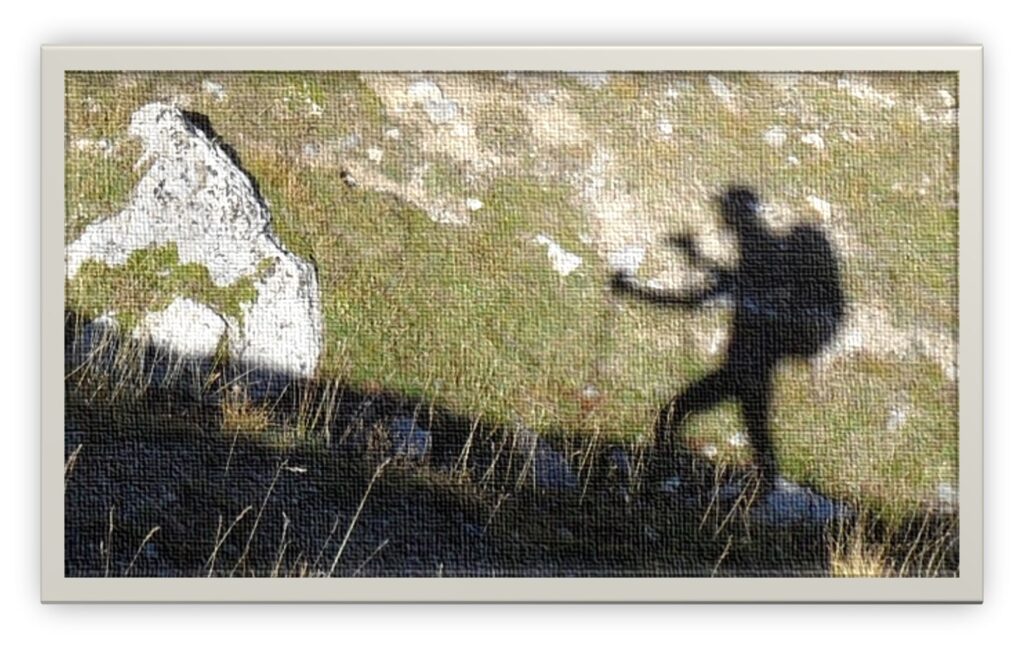If you love hiking, you know how important it is to pack smart and light. A heavy backpack can slow you down, tire you out, and ruin your experience. In this article, I shared some tips on how to optimize your backpack for hiking based on my recent trip to the Alps. I also showed you some of the best pictures I took along the way.
Backpack review
My backpack weighed about 10 kilograms, including food and water. That was about 15% of my own weight, which is considered too heavy for a comfortable hike. I realized that I could have optimized my backpack by leaving out some items that I didn’t really need or use.
Here are the main categories of items that I packed and how I could have improved them:

Food
I packed enough food for few days, including snacks and energy bars. I was getting usually my lunch picnic from the refuge every morning. I also brought a bottle with an integrated filter to purify water from streams and lakes. However, the bottle was heavy (221 grams) and bulky, and I didn’t use it much because there were plenty of water sources along the way. What I could have done better was to use a lighter flask with an integrated filter, such as the one from Salomon that weighs only 52 grams.
That would have saved me 169 grams of weight.
Clothes
I packed two first layer t-shirts, one for the night and one for hiking in cold days. I also packed two extra underwear and three extra socks. Additionally, I brought a rain over trousers, a light wind stopper jacket, and a down jacket for the evening. What I could have done better was to reduce the number of clothes by half. I only needed one first layer t-shirt, one extra underwear, and one extra pair of socks.
I could have also used a lighter rain over trousers, such as the one from Decathlon that weighs 197 grams instead of 364 grams.
The wind stopper jacket was unnecessary, as I preferred to wear my down jacket in the evening (and I had a heavier gore tex jacket).
By eliminating these items, I could have saved 476 grams of weight.
Books / electronics
I brought 3 of the 4 books (guides) of the GR5, each weighing over 200 grams. I was afraid to run out of battery if I had only the electronic version. However, the French version had detailed maps that the cicerone kindle version did not have. The paper version could be eliminated, as the route is very well signposted, and if you are not sure, you can always ask for directions. I was lucky to hike in summer, with no snow and no foggy days, which made navigation easier. At the end, I hiked an extra 10 kilometres on this 600-kilometre trip. I could save 671 grams by eliminating the paper books.
I brought a 20,000mAh Powerbank, which was more than enough for my phone, watch, and camera. However, a 10,000mAh would have been enough, and Nitecore has a very light one which weighs only 150 grams. I could have saved 250 grams.
I also brought a tripod for my camera, but I never used it, which means I could have saved 62 grams.
In total, I could have saved 983 grams on books and electronics.
Backpack / safety / sleep
I used the backpack I had. A TWINPEAK DLX 45 LITRE backpack. It was the correct size, but very heavy with 1.1kilograms. In Briancon, I had to buy a needle and thread to repair my backpack. The straps were coming off my backpack, and I needed it to last another week. I was missing pockets as well at the front of the bag to access the camera, the water and some food for the day without the need to remove the bag. I could reach the water bottle, but it was often by stretching the arms or removing one strap. I think a backpack like the Ultimate Direction fastpack 40 would be better. It weighs only 715 grams. I could save 405grams.
I brought a sleeping bag I had, but it was heavy and I never used it during the hike. I always slept in the refuges and my silk bag was enough. I have seen lighter versions of sleeping bags that weigh around 550 grams, and I could save 375 grams by switching to a lighter option.
I also brought soap, but I only used half of it, reducing its weight from 100 grams to 50 grams and allowing me to save 50 grams.
Overall, I could save a total of 830 grams on backpacks/sleep.
Total bag saving
With just a few adjustments and an investment of approximately 400€ (plus a saving of 50€ on books), I was able to reduce the weight of my backpack from 10 kg to 7.5 kg.
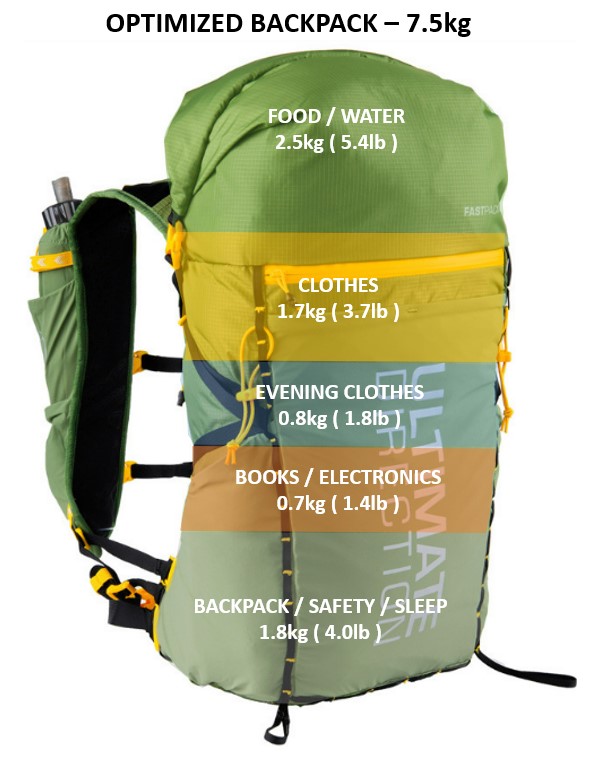
With further sacrifice of some comfort items such as a sleeping bag, hat, trousers, flip flops, and camera (replacing them with a Bivi bag, buff, rain trousers, phone), I could potentially reduce the weight by another 1.2 kg, resulting in a total weight of 6.3 kg.
Best period for the hike
I hiked in August, which is during the busiest period between July 14th and August 15th. Because many accommodations were fully booked, I had to make reservations several months in advance, especially for those near Chamonix and along the Tour du Mont Blanc. However, other popular areas such as the Vanoise or Mercantour parks also require advanced bookings, particularly if you plan to visit slowly. Additionally, there may be snow on the path in June, particularly in the northern section of the GR5.
As a result, the best periods for hiking would be the beginning of July or the end of August.
Hike duration
It took me 18 days to hike the 600km of the GR5 from Lake Geneva to Menton, including the GR52/Mercantour section. However, I believe that this route can be completed in 15 days with some optimization for someone with a similar fitness level as mine.
To achieve this, I would recommend cutting down some of the stages, as shown in the table below (including the estimated hike duration) :
| Stage | From | To | Distance [km] | Duration [h] |
| 1 | St Gingolf | La Chapelle d’Abondance | 19 | 4:30 |
| 2 | La Chapelle d’Abondance | Samoens | 44 | 10:30 |
| 3 | Samoens | Les Houches | 44 | 10:15 |
| 4 | Les Houches | Plan de la Laie | 40 | 9:30 |
| 5 | Plan de la Laie | Landry (ref. Rosuel) | 40 | 9:30 |
| 6 | Landry (ref. Rosuel) | Refuge de la Vanoise | 36 | 8:40 |
| 7 | Refuge de la Vanoise | Modane | 36 | 8:30 |
| 8 | Modane | Montgenevre | 50 | 11:45 |
| 9 | Montgenevre | Ceillac | 52 | 12:15 |
| 10 | Ceillac | Larche | 40 | 9:30 |
| 11 | Larche | Auron | 43 | 10:15 |
| 12 | Auron | Rimplas | 45 | 10:45 |
| 13 | Rimplas | Ref. Notre dame de Finestre | 41 | 10:45 |
| 14 | Ref. Notre dame de Finestre | Camp d’Argent | 30 | 9:15 |
| 15 | Camp d’Argent | Menton | 40 | 9:30 |
By following this proposed itinerary, the duration of the hike can be reduced from 18 days to 15 days. However, keep in mind that this will require a higher level of physical fitness and stamina, as the daily distances covered will be longer.
Physical preparation
I am a fit person who runs many miles and I would say my fitness level is good year-round. I did not specifically prepare for the GR5, but before undertaking such a long hike, I would suggest that anyone increase their daily walking mileage and be able to comfortably walk 4 to 6 hours on undulating terrain.
My physical problems during the GR5
On days 3 to 5 or 6, I experienced pain in my quads due to the downhill sections of the first 2 days. I reduced my speed during descents because of the pain. This could have been avoided if I had prepared myself in the month before the hike by doing longer mountain descents on rough terrain with a heavy backpack. The pain would have occurred during these training sessions rather than during the hike.
Day 8 was scary because of the shin splint. I was afraid it might be a stress fracture. Similar to the quads pain, it could have been avoided with better training, specifically going down mountains with a heavy backpack. During my daily hikes, I always go light, but to prepare the body for the extra weight, the training hikes should be done with a heavy backpack.
I think the shin splint arrived on Day 8 because the pain in my quads delayed it by a few days. I started to move faster on days 6 to 8, especially on descents. Even if your legs feel good, it is important to protect your body during such a long trip. Keep a reasonable pace when going down mountains. The 10kg extra weight on your back is heavy for your legs/feet.
Advises
To avoid injuries, gradually increase your daily mileage during the first week of the hike and insert an easy day with fewer miles to allow your body to recover.
When planning the trip, allow for some extra days to be able to reduce some stages. I reduced days 10 and 11 to help my body heal.
Use the first week as a training week too. By the end of the hike, you will be stronger and able to push yourself more.
Best pictures
I will not put to many words in this part, and just share few pictures that impacted me:
GR5 Sign:
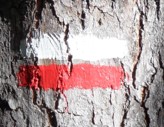
Animals:

Buildings:
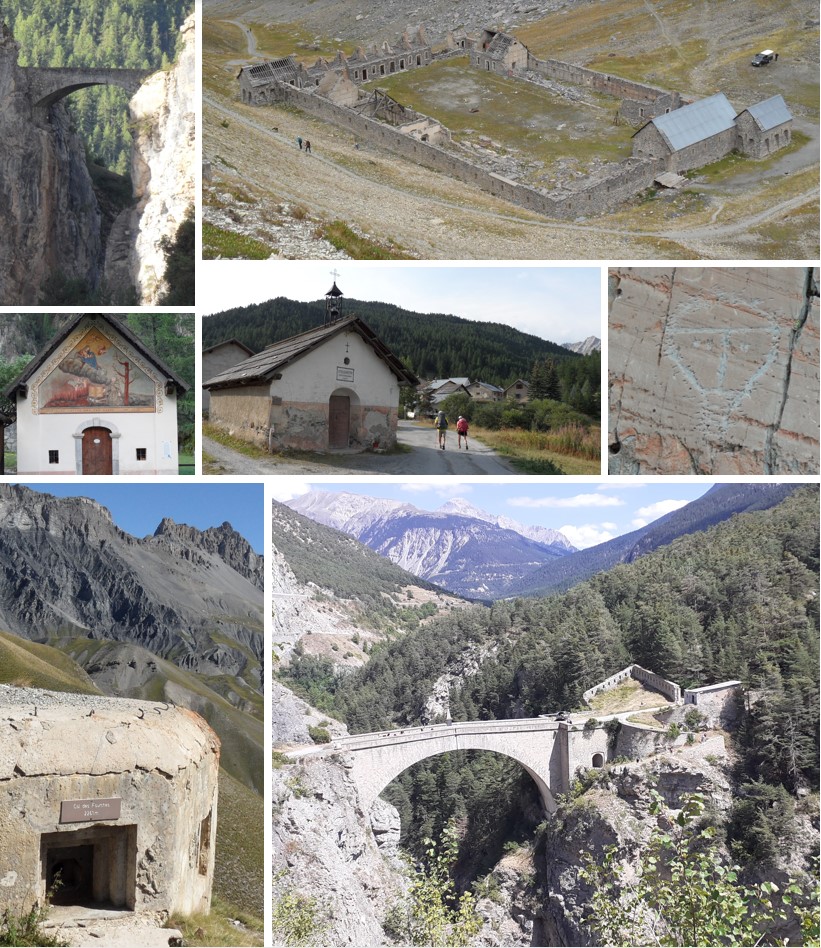
Flowers/ food / smells:
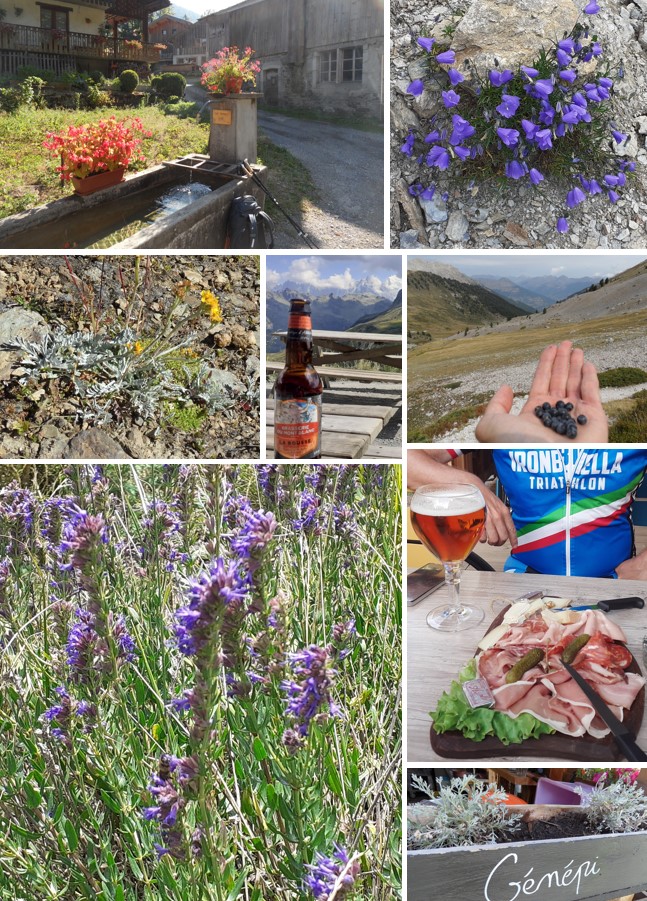
Landscapes:

Finish:

Conclusion
What an incredible journey it has been! This hike was an adventure beyond compare, filled with unforgettable moments and breath-taking views that will forever be etched in my memory. As I read back through these articles, I realize just how much I have experienced and how much I have grown from this experience.
Now that the journey has come to an end, it’s time to reconnect with everyday life. Yet, I feel as though a part of me is still out there on the trail, seeking new challenges and exploring new landscapes. This adventure has shown me the beauty of simplicity, the value of perseverance, and the importance of taking time to disconnect from the distractions of the modern world.
As I move forward, I know that the lessons I have learned on this journey will stay with me for a lifetime. I am grateful for every step, every climb, and every moment of this incredible adventure, and I look forward to the next chapter of my hiking journey.
